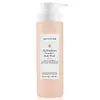What's inside
What's inside
 Key Ingredients
Key Ingredients

 Benefits
Benefits

 Concerns
Concerns

 Ingredients Side-by-side
Ingredients Side-by-side

Water
Skin ConditioningCocamidopropyl Hydroxysultaine
CleansingGlycerin
HumectantSodium Lauroyl Sarcosinate
CleansingNiacinamide
SmoothingGluconolactone
Skin ConditioningSodium Methyl Cocoyl Taurate
CleansingPEG-150 Pentaerythrityl Tetrastearate
EmulsifyingSalicylic Acid
MaskingSodium Benzoate
MaskingZea Mays Oil
EmulsifyingDisodium EDTA
Sodium Lauroyl Lactylate
EmulsifyingCeramide 3
Skin ConditioningCholecalciferol
Phytosphingosine
Skin ConditioningCholesterol
EmollientSodium Hyaluronate
HumectantXanthan Gum
EmulsifyingCarbomer
Emulsion StabilisingCeramide 1
Skin ConditioningWater, Cocamidopropyl Hydroxysultaine, Glycerin, Sodium Lauroyl Sarcosinate, Niacinamide, Gluconolactone, Sodium Methyl Cocoyl Taurate, PEG-150 Pentaerythrityl Tetrastearate, Salicylic Acid, Sodium Benzoate, Zea Mays Oil, Disodium EDTA, Sodium Lauroyl Lactylate, Ceramide 3, Cholecalciferol, Phytosphingosine, Cholesterol, Sodium Hyaluronate, Xanthan Gum, Carbomer, Ceramide 1
Water
Skin ConditioningSodium Cocoyl Isethionate
CleansingCocamidopropyl Hydroxysultaine
CleansingGlycerin
HumectantCoco-Glucoside
CleansingSodium Methyl Cocoyl Taurate
CleansingSodium Hyaluronate
HumectantAcrylates/C10-30 Alkyl Acrylate Crosspolymer
Emulsion StabilisingAscorbyl Glucoside
AntioxidantPapain
Skin ConditioningNiacinamide
SmoothingBromelain
Skin ConditioningSodium PCA
HumectantVaccinium Myrtillus Bud Extract
AntioxidantSaccharum Officinarum Extract
MoisturisingCitrus Limon Fruit Extract
MaskingAcer Saccharum Extract
Skin ConditioningCitrus Aurantium Dulcis Fruit Extract
MaskingGlycol Distearate
EmollientPolyquaternium-51
Skin ConditioningCaprylic/Capric Triglyceride
MaskingCitrus Aurantium Amara Leaf/Twig Extract
Skin ConditioningPhenoxyethanol
PreservativeCocamide Mipa
EmulsifyingTriethyl Citrate
MaskingSodium Hydroxide
BufferingEthylhexylglycerin
Skin ConditioningUrea
BufferingTetrasodium Glutamate Diacetate
Trehalose
HumectantMaltodextrin
AbsorbentWater, Sodium Cocoyl Isethionate, Cocamidopropyl Hydroxysultaine, Glycerin, Coco-Glucoside, Sodium Methyl Cocoyl Taurate, Sodium Hyaluronate, Acrylates/C10-30 Alkyl Acrylate Crosspolymer, Ascorbyl Glucoside, Papain, Niacinamide, Bromelain, Sodium PCA, Vaccinium Myrtillus Bud Extract, Saccharum Officinarum Extract, Citrus Limon Fruit Extract, Acer Saccharum Extract, Citrus Aurantium Dulcis Fruit Extract, Glycol Distearate, Polyquaternium-51, Caprylic/Capric Triglyceride, Citrus Aurantium Amara Leaf/Twig Extract, Phenoxyethanol, Cocamide Mipa, Triethyl Citrate, Sodium Hydroxide, Ethylhexylglycerin, Urea, Tetrasodium Glutamate Diacetate, Trehalose, Maltodextrin
 Reviews
Reviews

Ingredients Explained
These ingredients are found in both products.
Ingredients higher up in an ingredient list are typically present in a larger amount.
Cocamidopropyl Hydroxysultaine is a synthetic cleansing agent, though it is derived from coconut oil.
It is used to enhance the texture of products by boosting lather and thickening the texture. As a cleanser, Cocamidopropyl Hydroxysultaine is mild.
Glycerin is already naturally found in your skin. It helps moisturize and protect your skin.
A study from 2016 found glycerin to be more effective as a humectant than AHAs and hyaluronic acid.
As a humectant, it helps the skin stay hydrated by pulling moisture to your skin. The low molecular weight of glycerin allows it to pull moisture into the deeper layers of your skin.
Hydrated skin improves your skin barrier; Your skin barrier helps protect against irritants and bacteria.
Glycerin has also been found to have antimicrobial and antiviral properties. Due to these properties, glycerin is often used in wound and burn treatments.
In cosmetics, glycerin is usually derived from plants such as soybean or palm. However, it can also be sourced from animals, such as tallow or animal fat.
This ingredient is organic, colorless, odorless, and non-toxic.
Glycerin is the name for this ingredient in American English. British English uses Glycerol/Glycerine.
Learn more about GlycerinNiacinamide is a multitasking form of vitamin B3 that strengthens the skin barrier, reduces pores and dark spots, regulates oil, and improves signs of aging.
And the best part? It's gentle and well-tolerated by most skin types, including sensitive and reactive skin.
You might have heard of "niacin flush", or the reddening of skin that causes itchiness. Niacinamide has not been found to cause this.
In very rare cases, some individuals may not be able to tolerate niacinamide at all or experience an allergic reaction to it.
If you are experiencing flaking, irritation, and dryness with this ingredient, be sure to double check all your products as this ingredient can be found in all categories of skincare.
When incorporating niacinamide into your routine, look out for concentration amounts. Typically, 5% niacinamide provides benefits such as fading dark spots. However, if you have sensitive skin, it is better to begin with a smaller concentration.
When you apply niacinamide to your skin, your body converts it into nicotinamide adenine dinucleotide (NAD). NAD is an essential coenzyme that is already found in your cells as "fuel" and powers countless biological processes.
In your skin, NAD helps repair cell damage, produce new healthy cells, support collagen production, strengthen the skin barrier, and fight environmental stressors (like UV and pollution).
Our natural NAD levels start to decline with age, leading to slower skin repair, visible aging, and a weaker skin barrier. By providing your skin niacinamide, you're recharging your skin's NAD levels. This leads to stronger, healthier, and younger looking skin.
Another name for vitamin B3 is nicotinamide. This vitamin is water-soluble and our bodies don't store it. We obtain Vitamin B3 from either food or skincare. Meat, fish, wheat, yeast, and leafy greens contain vitamin B3.
The type of niacinamide used in skincare is synthetically created.
Learn more about NiacinamideSodium Hyaluronate is hyaluronic acid's salt form. It is commonly derived from the sodium salt of hyaluronic acid.
Like hyaluronic acid, it is great at holding water and acts as a humectant. This makes it a great skin hydrating ingredient.
Sodium Hyaluronate is naturally occurring in our bodies and is mostly found in eye fluid and joints.
These are some other common types of Hyaluronic Acid:
Learn more about Sodium HyaluronateThis gentle cleansing and foaming ingredient is known for leaving a smooth feeling in skin and hair. It is made using coconut oil.
According to the manufacturer, it is soluble in water and has resistance to hard water, acid, and alkali.
Due to its coconut base, it may not be Malassezia folliculitis safe.
Learn more about Sodium Methyl Cocoyl TaurateWater. It's the most common cosmetic ingredient of all. You'll usually see it at the top of ingredient lists, meaning that it makes up the largest part of the product.
So why is it so popular? Water most often acts as a solvent - this means that it helps dissolve other ingredients into the formulation.
You'll also recognize water as that liquid we all need to stay alive. If you see this, drink a glass of water. Stay hydrated!
Learn more about Water